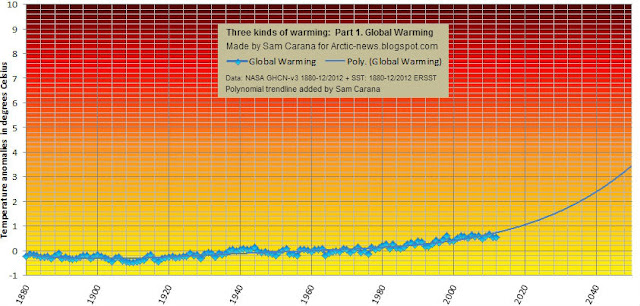If we take the NASA Annual Mean Land-Ocean Temperatures and draw a projection into the future, temperatures will quickly be 3 degrees Celsius higher than the base period (1951-1980), i.e. well before 2050, as illustrated on image 1. below.
 |
| Image 1. Temperatures will be 3 degrees Celsius higher well before 2050 |
Above projection appears to be steeper than even the worst-case scenario pictured by the IPCC for years, such as on the image below.
As it turned out, the models used by the IPCC made all kinds of assumptions that didn't eventuate. But before deciding to instead settle for a relatively simple extrapolation of observed data, there are some issues that require a further look.
As discussed in the earlier post Accelerated Arctic Warming, temperatures in the Arctic have been rising at a much faster pace than global temperatures, and if this accelerated rise continues, we can expect a 10 degrees Celsius rise in the Arctic before 2040, as illustrated by image 3. below.
 |
| Image 3. Three kinds of warming - 2: Accelerated warming in the Arctic |
Such a temperature rise in the Arctic will undoubtedly lead to additional greenhouse gas emissions in the Arctic, of carbon dioxide, nitrous oxide and particularly methane, threatening to trigger runaway global warming.
The image below, from the methane-hydrates blog, combines these three kinds of warming, showing global temperatures that soon catch up with accelerated Arctic warming, as heatwaves at high latitudes will cause wildfires, in particular in Siberia, where firestorms in peat-lands, tundras and forests could release huge amounts of emissions, including soot, much of which could settle on the Himalayan plateau, darkening the ice and snow and resulting in more local heat absorption. Rapid melt of glaciers will then cause flooding at first, followed by dramatic decreases in the flow of river water that up to a billion people now depend on for water supply and irrigation.
In other words, the situation looks much more dire than what most models make us believe; the more reason to adopt the climate plan that is also described at the post at the methane-hydrates blog.
 |
| Image 4. Three kinds of warming - 1, 2 and 3 |
References
- IPCC (AR4) - Climate Change 2007: Working Group I: The Physical Science Basis
- Accelerated Arctic Warming
- Methane hydrates

